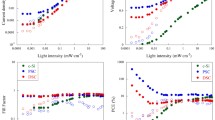Abstract
The characteristics of a solar cell, the short-circuit current (I sc ), the open-circuit voltage (V oc ), the maximum power point (V m , I m ), the fill factor (FF) and the photoelectric conversion efficiency (η) under different illumination intensities and shading areas have been experimentally investigated. The work factor ω is given by ω = (1 - A/A 0) × S/S 0, where A 0 is the total solar cell area, A the shading area, S 0 the benchmark reference irradiation level, and S the new level of the irradiation, is introduced to take the light intensity and shading area into account. The results show that Isc and Im increase on an approximately linear increasing way with ω, but V oc and V m approach the saturation levels. The reason is that the current is a linear function of ω, and the relationship of the voltage to ω is logarithmic. We also found I sc (V m ) to depend more on ω than I m (V oc ). In addition, we observed that η tended to increase linearly with ω, but FF tended to converge to saturation. The reason for the behavior of η is the reduction in the contact resistance and in the electron-hole recombination with increasing ω. However, FF is mainly determined by V oc . The improvement in the solar cell performance with increasing ω results from an increase in the current, but not in the voltage or the fill factor.
Similar content being viewed by others
References
B. Parida, S. Iniyan and R. Goic, Renew. Sust. Energ. Rev. 15, 1625 (2011).
J. T. Liu, X. H. Deng, W. Yang and J. Li, Phys. Chem. Chem. Phys. 17, 3303 (2015).
H. Ohtsuka, M. Sakamoto, M. Koyama, K. Tsutsui, T. Uematsu and Y. Yazawa, Prog. Photovoltaics Res. Appl. 9, 1 (2001).
H. Helmers, M. Schachtner and A. W. Bett, Sol. Energ. Mat. Sol. C 116, 144 (2013).
P. Singh, S. N. Singh, M. Lal and M. Husain, Sol. Energ. Mat. Sol. C 92, 1611 (2008).
W. C. Yang, C. Lo, C. Y. Wei and W. S. Lour, IEEE Electron Device Lett. 32, 1412 (2011).
D. Cheyns, B. P. Rand, B. Verreet, J. Genoe, J. Poortmans and P. Heremans, Appl. Phys. Lett. 92, 243310 (2008).
D. D’Ercole, L. Dominici, T. M. Brown, F. Michelotti, A. Reale and A. D. Carlo, Appl. Phys. Lett. 99, 213301 (2011).
M. C. Alonso-García, J. M. Ruiz and F. Chenlo, Sol. Energ. Mat. Sol. C 90, 329 (2006).
J. B. Bai, Y. Cao, Y. Z. Hao, Z. Zhang, S. Liu and F. Cao, Sol. Energy 112, 41 (2015).
F. Khan, S. N. Singh and M. Husain, Sol. Energ. Mat. Sol. C 94, 1473 (2010).
A. A. Ghoneim, K. M. Kandil, A. Y. Al-Hasan, M. S. Altouq, A. M. Al-asaadil, L. M. Alshamari and A. A. Shamsaldein, Energy Sci Tech. 2, 43 (2011).
V. Quaschning and R. Hanitsch, in Photovoltaic Specialists Conference (Washington, U.S.A, May 13-17, 1996), p. 1287.
A. Dolara, G. C. Lazaroiu, S. Leva and G. Manzolini, Energy 55, 466 (2013).
F. Al-Amri and T. K. Mallick, Int. J. Photoenergy 2014, 642819 (2014).
H. M. Tian, F. Mancilla-David, K. Ellis, E. Muljadi and P. Jenkins, Sol. Energy 95, 1 (2013).
H. J. Solheim, H. G. Fjær, E. A. Sørheim and S. E. Foss, Energy Procedia 38, 183 (2013).
M. García, L. Marroyo, E. Lorenzo, J. Marcos and M. Pérez, Prog. Photovoltaics Res. Appl. 22, 1292 (2014).
A. El-Shaer, M. T. Y. Tadros and M. A. Khalifa, Intern. J. Emerging Tech. Adv. Engin. 4, 311 (2014).
E. Cuce, P. M. Cuce and T. Bali, Appl. Energ. 111, 374 (2013).
D. Sera, R. Teodorescu and P. Rodriguez, in Industrial Electronics (Vigo, Spain, June 4-7, 2007), p. 2392.
S. M. Sze and K. K. Ng, Physics of Semiconductor Devices, third edition (John Wiley & Sons, Hoboken, 2007), p. 663.
W. D. Soto, S. A. Klein and W. A. Beckman, Sol. Energy 80, 78 (2006).
Z. T. Zhai, Ph. D dissertation, University of Science and Technology of China, 2008.
M. Sabry and A. E. Ghitas, Vacuum 80, 444 (2006).
S. R. Wenham, M. A. Green, M. E. Watt and R. Corkish, Applied Photovaltaics, second edition (Earthscan, London, 2007), p. 43.
Author information
Authors and Affiliations
Corresponding author
Rights and permissions
About this article
Cite this article
Xiao, W.B., Hu, F.Y., He, X.D. et al. Experimental investigation on the characteristics of a solar cell under different illumination intensities and shading areas. Journal of the Korean Physical Society 66, 1645–1648 (2015). https://doi.org/10.3938/jkps.66.1645
Received:
Accepted:
Published:
Issue Date:
DOI: https://doi.org/10.3938/jkps.66.1645




